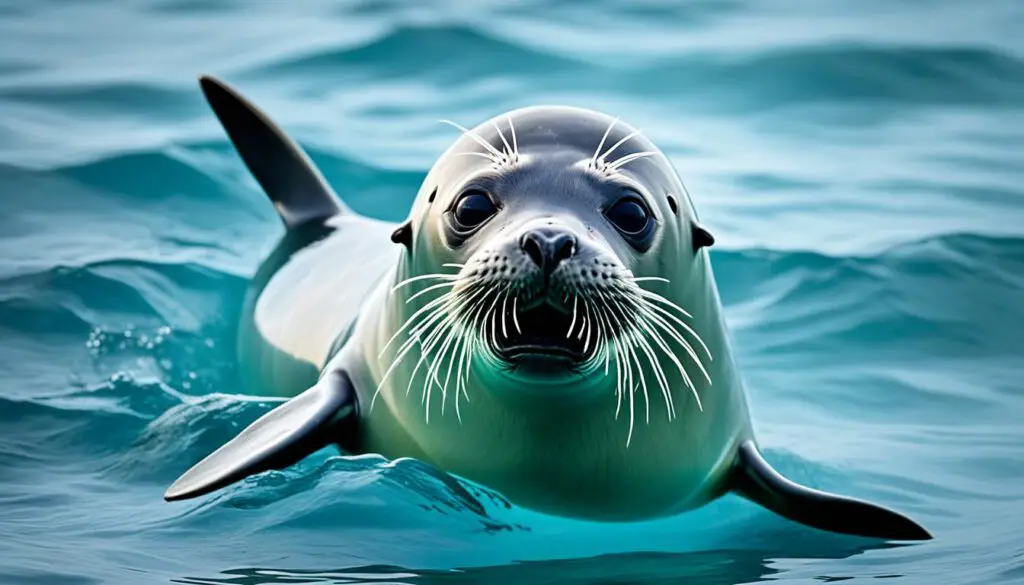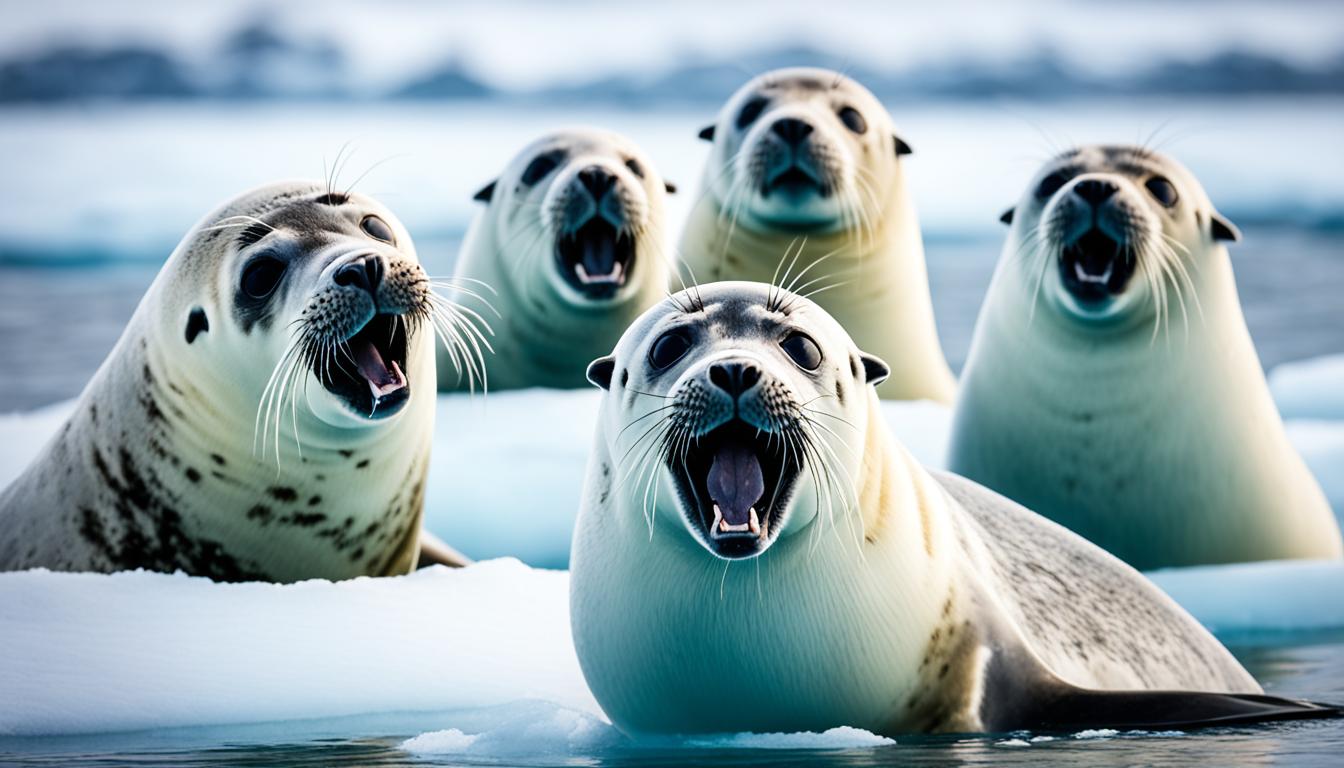Seal communication is key for those into marine biology and wildlife. You might ask, how do seals talk to each other? This piece looks into the ways these sea creatures share messages. They use sounds, body language, and social actions. Learning about these methods helps us understand marine mammal communication better and its role in their lives.
Understanding Seal Communication
Seals are fascinating creatures that belong to the pinniped family. They have unique ways of communicating in both the water and on land. They use seal communication signals to share information with each other.
On land, seals use visual signals to talk to each other. You might see them using body postures, movements, and facial expressions. These signals help them understand each other in their social groups.
Underwater, seals communicate mainly through sound. They make different sounds and signals that can travel far through the water. This shows how important it is to understand how seals communicate.
Knowing how seals communicate in different ways helps us appreciate these amazing marine animals more. Here’s a table that shows how seals communicate in different places:
| Setting | Communication Mode | Examples |
|---|---|---|
| Land | Visual | Body posture, facial expressions, movements |
| Underwater | Auditory | Vocalizations, clicks, grunts |
How Do Seals Communicate?
Seals have special ways to talk to each other in their groups. They use sounds and body language to send messages. When asking how do seals communicate?, we look at their vocal sounds and how they stand or move.
Seals make different noises like clicks, growls, and barks. These sounds are key in breeding seasons when they interact more. Their body language is also crucial. It tells us about their mood, status, and what they plan to do.
For example, a seal might stand tall and open its mouth to show it’s aggressive. But if it’s calm, it will sit or lie down. This shows how important body language is in seal communication.
Learning about seal communication shows how complex they are in the wild. Here’s a quick look at how seals talk to each other:
- Vocalizations: Seals make sounds to express their needs and talk to others.
- Body Language: Their movements and positions tell us about their social rank and plans.
- Contextual Communication: Seals change how they sound and move based on where they are and who they’re with.
These facts show how smart and adaptable seals are in the ocean. They have many ways to connect with each other, making their lives fascinating.
Vocalizations of Seals
Seals use sounds to talk to each other underwater. These sounds help them connect and live together in their ocean homes. By studying these sounds, we learn about their social lives and how they adapt to different places.
Underwater Sounds and Their Purposes
Seals make many sounds underwater, like clicks, growls, and roars. Each sound has a special meaning, often tied to social interactions or claiming territory. For example, clicks help them find each other, while growls warn others or show aggression. Roars are loud calls that show who’s boss, especially when finding a mate.
These sounds are key to their social life. They keep groups together and sort out who’s in charge.
Different Types of Vocalizations
Seals make a variety of sounds, both in the water and on land. These calls are vital for talking to each other. Gray seals, for instance, bark and whine when they’re looking for love or talking to their babies. Each sound has its own role in their social world, changing based on the situation.
| Type of Vocalization | Purpose | Example |
|---|---|---|
| Clicking | Navigation and location | Used during foraging |
| Growling | Aggression and territory defense | Warning competitors |
| Roaring | Dominance assertion | Mating displays |
| Barking | Communication with pups | Mother-pup interactions |
Seal Body Language
Understanding seal body language is key to knowing how they interact. Seals mainly talk through looks, showing their feelings and social behavior. These signs can show everything from aggression to friendship.
Visual Communication Signals
Seals use visual cues to share their feelings and plans. Important signals include:
- Posturing: The way seals stand shows if they’re in charge or not.
- Movement: Fast, random moves might mean they’re upset, while slow, careful moves show they’re calm.
- Facial Expressions: Changes in their face, like whisker position, send out social messages.
Posturing During Interactions
When seals meet, they use certain postures to share info. Standing tall often means they’re ready and alert. But, going down low might show they’re not in charge. These signs are key when they’re on land, since they can’t really talk.
| Posture | Meaning |
|---|---|
| Upright | Alertness or dominance |
| Lowered | Submission or relaxation |
| Rolling | Playfulness or social bonding |
| Head bobbing | Curiosity or warning |
By looking at seal body language, we can learn a lot about their social lives. This helps us understand these amazing sea creatures better.
Social Behavior in Seals
The social behavior in seals shows complex ways of interacting. These interactions help keep social bonds strong and clear who’s in charge. Seals live together in groups for breeding, resting, and important social talks. They use different seal communication methods to get closer and know each other better.
In breeding seasons, social behavior in seals gets even more interesting. Males fight for females, making loud sounds and showing off. They use both sounds and body language to talk and understand each other.
Young seals learn important social skills by being with others. They watch adults to learn how to act and communicate. This helps them fit in and talk well with their group.
Underwater Communication in Seals
Underwater, communication is tough, making sound key for seals. These creatures live under the sea, using sound waves a lot. They need to make and understand sounds to talk, hunt, and hang out with others.
The Role of Sound in Marine Environments
Sound moves better under water than in air. This helps seals talk to each other over long distances. They use sound to stay connected, find food, and stay safe from danger. Studies show seals use different sounds and ways to find their way around.
- Echolocation helps seals find things and prey in deep, dark water.
- Seals make many sounds like barks, whistles, and clicks, each with its own meaning.
- Sound travels well under water, helping seals talk clearly even in cold, rough water.
Learning about sound in seals tells us more about how they survive. It shows how they’ve adapted to life in the water. As scientists keep studying, we’ll learn more about how seals interact with each other.

Seal Communication Research
Seal communication research is uncovering the complex ways seals talk to each other. This research deepens our knowledge of these fascinating marine mammals. Scientists are looking closely at their sounds and body language. This helps us understand how seals interact with each other.
Recent studies show that seals have different ways of communicating, depending on the species. Each species has its own special way of sending messages. This knowledge is crucial for protecting seals and their homes.
By studying how seals communicate, scientists can help protect them better. This research is important for understanding how seals live in their environment. It also shows how things like climate change might affect their communication.
As seal communication research grows, we learn more about these creatures. This knowledge helps us protect the marine world and its magical inhabitants.










